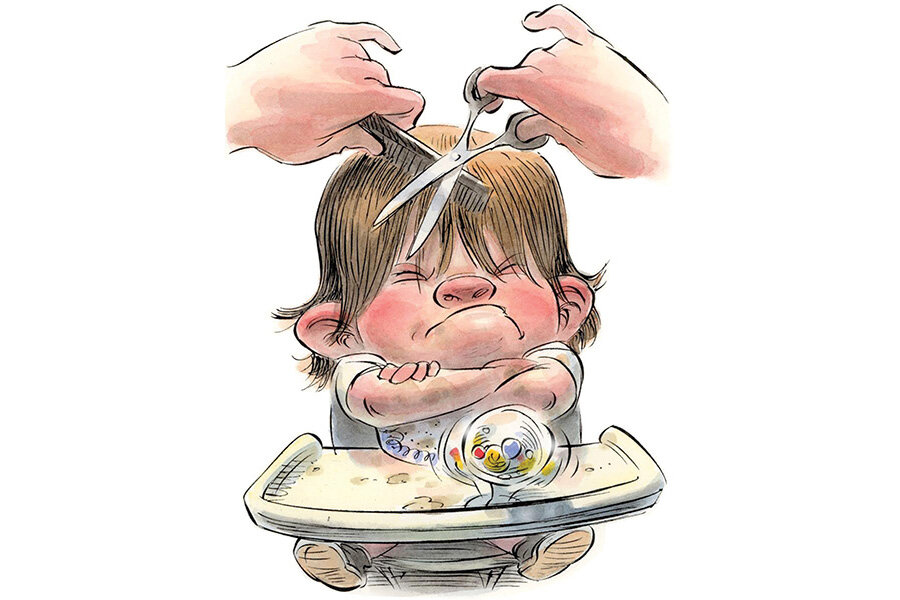Free haircuts – but at a cost
Loading...
My best friend, an optimist, once insisted that I cut her hair. She may have misunderstood the extent of my haircutting experience. I had been trimming my own bangs for years, but otherwise my previous clients included only a horse and two Barbie dolls, all of whom had shown a refreshing lack of vanity.
“Make it short,” my friend told me, perhaps driven to recklessness by a streak of hot weather. I made it short. It was too bad she needed to renew her driver’s license and pose for an updated photo the following week. Even though I apologized, she never asked me for a haircut again. She had learned her lesson. My family has not.
In all the years I have known my husband, he has never visited a barber. When he first asked me to cut his hair, I offered to show him my friend’s driver’s license photo. But he was not deterred. Fortunately, my task was simple, comparable to mowing a small lawn, extra-short, and weed-whacking a little around the edges. I have since repeated this procedure more than a hundred times, often managing to retain both sideburns. For our two kids, it has never been that easy.
When our older son was about 9 months old, I decided it was time for baby’s first haircut. His dark hair grew long and straight over his ears, in contrast to the bald spot he had worn on the back of his head from lying on his crib mattress. Picture a young Ebenezer Scrooge, minus the mutton chops. I buckled him into his highchair and stuck a toy on the tray with a suction cup. But when I held up my scissors, he arched his back and started shrieking, clearly convinced he was in a fight for his life. I put down my scissors. It was not time for baby’s first haircut.
For the next year or so, I performed stealth haircuts, creeping into my son’s room at night and clipping a few tufts as he slept. As the months passed, his bald spot filled in and his hair grew as dense as a hedge, with a snarl of cowlicks sprouting from his crown. He still resisted our efforts to comb it. If he didn’t get a haircut soon, we’d have to shave his head.
But he was leery of strangers; a professional trim probably would have been impossible without anesthesia.
I tried to sell my son on the idea of his approaching haircut. We would give some of his hair to wild birds, I told him, so they could make soft, warm nests for their babies. And while I “harvested” his hair, he would be allowed to watch a feature-length movie involving model trains – a movie usually kept hidden, as it proved fascinating for toddlers, yet so excruciating for adults it would warrant consideration as an interrogation tool.
Portable DVD players and tablet computers had not yet become staples, so I parked a chair on a sheet in front of the television. I turned on the VCR, and my son slid into his seat, already falling under the influence of tooting trains and earnest dialogue. As I combed and clipped, he forgot to protest, except to complain that his neck felt too itchy.
Before the last whistle died away, we were finished. His hair looked a bit jagged in front but was short enough to withstand infrequent combing – a success. We left a pile of prickly hair clippings in the backyard for the birds.
As my son grew older and was joined by a little brother, I continued to serve as family barber. My skills improved, but results were mixed. One ill-timed wiggle could set off a disastrous cascade of events, as I struggled to adjust the rest of a style to a gouge in back or bangs gone wrong. And when my youngest watched The Three Stooges during one cut, his hair ended up looking suspiciously like Moe’s – reason enough to dump the Stooges, even if the kids hadn’t started calling me “Toots.”
With my firstborn now in his teens, I wonder how long I can continue with DIY hairstyling. When I was his age, the boys in my class were busy blow-drying and feathering, and carrying long-handled combs in their back pockets. Surely he would rather go to a professional.
“No,” he says. “Too boring.”
The last time my son needed a haircut, I asked how he wanted it to look. He ran his hands through his hair, which still grows as dense as a hedge, as it did when he was 2.
“I like it when there’s not so much of it.”
For me, that was a realistic goal. I picked up the scissors and started to snip, hoping for the best.







